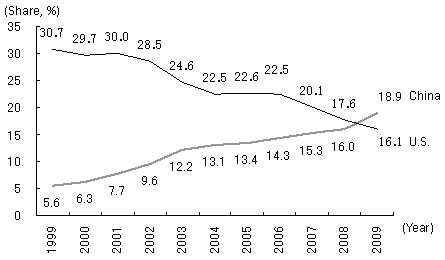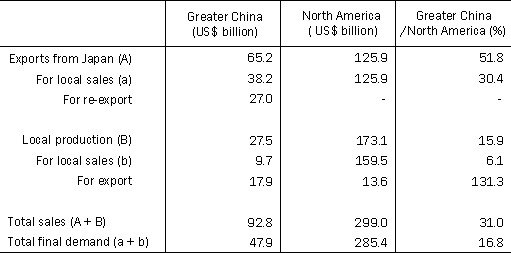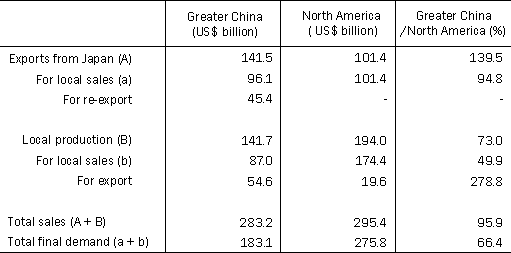In recent years, with its economy growing remarkably, China has become more and more important for Japan, not only as a production base but also as a market. As if to symbolize this trend, Japan's exports to China exceeded exports to the United States in 2009 for the first time in the postwar period, making it Japan's largest export market( figure 1 ).
Figure1 : China replaces United States as Japan's largest export market

(Source) Ministry of Finance, Trade Statistics of Japan
In addition to "exporting from their headquarters," another way for Japanese firms to access overseas markets is to "produce and sell locally." The Trade Statistics of Japan published by the Ministry of Finance provides data for the former and the Quarterly Survey of Overseas Subsidiaries compiled by the Ministry of Economy, Trade and Industry, provides data for the latter. Here we confirm the size of the Chinese market for Japanese firms in comparison with the U.S. market based on these two sets of statistics ( table 1 ). Limited by the availability of data, we will primarily analyze changes after 2002 based on the geographical classification of Greater China that adds Hong Kong to mainland China and North America as the United States plus Canada ( note 1 ).
Exports to Greater China exceeding those to North America
First, on the trade front, exports from Japan to Greater China increased from 65.2 billion dollars to 141.5 billion dollars between 2002 and 2009, while their share of overall Japanese exports rose from 15.7% to 24.4%. By contrast, Japanese exports to North America declined from 125.9 billion dollars to 101.4 dollars, while their share of overall Japanese exports fell from 30.3% to 17.5%. As a result, exports from Japan to Greater China exceeded shipments to North America by approximately 40%.
Table1 : Overseas Markets for Japan: Comparison of Greater China with North America
1) Year 2002

2) Year 2009

(Source) Based on Ministry of Economy, Trade and Industry's Quarterly Survey of Overseas Subsidiaries (fourth quarter of 2009, preliminary data), JETRO's Japanese Trade and Investment Statistics , Japanese Trade in dollars (original document is Ministry of Finance's Trade Statistics of Japan ), and customs statistics of China
However, exports to Greater China include not only products for local sales but also many intermediate goods such as parts that are processed and re-exported overseas. Assuming that the ratio of processing trade to overall imports of China (32.1% in 2009) can be applied to Chinese imports from Japan (Japanese exports to China), it is estimated that 45.4 billion dollars of Japanese exports to Greater China were processed and re-exported from China in 2009, while the remaining 96.1 billion dollars were sold locally, equivalent to 94.8% of Japanese exports to North America ( note 2 ).
Local production and sales in Greater China catching up those in North America
Meanwhile, local production by Japanese firms in Greater China increased from 27.5 billion dollars to 141.7 dollars between 2002 and 2009, of which local sales jumped from 9.7 billion dollars to 87.0 billion dollars. By contrast, both local production and local sales by Japanese firms in the United States grew at a sluggish pace.
As a result, local production in Greater China was already at 73.0% of that in North America in 2009. However, local sales in Greater China were still only 49.9% of that in North America, reflecting the fact that the local sales ratio (ratio of local sales to local production) in Greater China is much lower than the ratio in North America.
Even in Greater China, however, the local sales ratio has been steadily rising, from 35.3% in 2002 to 61.4% in 2009. This is largely attributable to a sharp increase in automobile production targeting the local market. Auto sales in China reached 13.64 million units in 2009 to become the world's largest for the first time, surpassing the United States. As far as passenger cars are concerned, Japanese automakers took the lead among foreign automakers by selling 2,197,000 units in 2009 to account for 21.3% of the total (10,331,000 units), according to the China Association of Automobile Manufacturers.
China is becoming the largest overseas market for Japan
The market sizes of China and the United States for Japanese firms can be expressed by "total sales," which combines exports from Japan to China and local production by Japanese firms, or "total final demand" that combines local sales of exports from Japan to China and local sales of local production by Japanese firms. According to these data, "total sales" in Greater China rose from 31.0% to 95.9% of the level in North America from 2002 to 2009, while "total final demand" increased from 16.8% to 66.4% of that in North America.
As these figures show, the overseas market for Japan has been shifting rapidly from North America to Greater China. This reflects the fact that Greater China has been growing much faster than North America in terms of GDP as well as market size. As this trend is expected to continue, the day when China will replace the United States to become the largest overseas market for Japan, in terms of "total sales" as well as "total final demand," is not far off.


